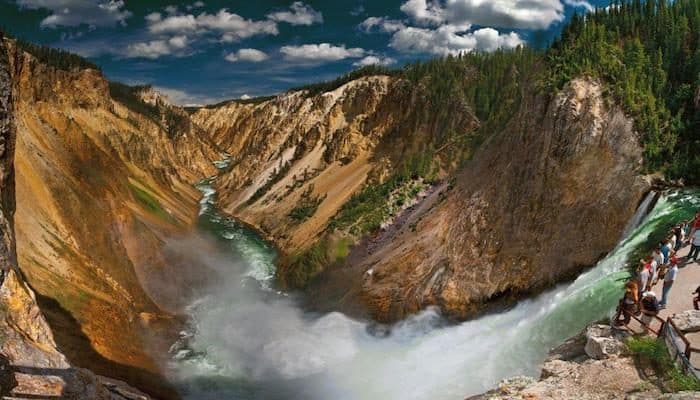
Features:
Categories:
The world’s first national park. Yellowstone National Park showcases colorful hot springs, mudpots, and geysers, in addition to its dramatic mountains, forests, lakes and wildlife. This park is located primarily in the U.S. state of Wyoming, although it also extends into Montana and Idaho. It is the centerpiece of the Greater Yellowstone Ecosystem, the largest remaining nearly-intact ecosystem in the Earth’s northern temperate zone. Hundreds of species of mammals, birds, fish and reptiles have been documented, including several that are either endangered or threatened. The vast forests and grasslands also include unique species of plants. Grizzly bears, wolves, and free-ranging herds of bison and elk live in the park. Paved roads provide close access to the major geothermal areas as well as some of the lakes and waterfalls.
NOTE: Yellowstone is bear country, so special safety measures must be taken. Running is different than walking or hiking. When you encounter a bear at running speed, they are more likely to feel threatened. We talked extensively with Yellowstone National Park Rangers, and although there are some wonderful running routes within the park, they are very concerned about visitor and bear safety. Overall, Park Rangers advise against running in the park. If you are going to run, it is recommended to run in groups, make noise going around corners, carry bear spray, and choose trails that are open with good visibility (like the ones featured below). Before your first run or hike, check in at a Visitors Center or Ranger Station to learn about the current bear activity.
Yellowstone climate is greatly influenced by altitude, with lower elevations generally found to be warmer year round. During the summer months of June through early September, daytime highs are normally in the 70 to 80 °F range, while night time lows can go to below freezing. Summer afternoons are frequently accompanied by thunderstorms. Spring and fall temperatures range between 30 and 60 °F with nights in the teens to single digits. Winter in Yellowstone is accompanied by high temperatures usually between zero and 20 °F and nighttime temperatures below 0 °F for most of the winter. There’s lots of snow.
Yellowstone has five entrance stations: the North Entrance located near Gardiner, MT., the West Entrance near West Yellowstone, MT., the East Entrance near Cody, WY., the South Entrance near Jackson, WY., and the Northeast Entrance near Silver Gate and Cooke City, MT. Make sure to carefully read about access at each station at different times of year.
West Yellowstone Area
Riverside Trail Loop. 10 km, 132 foot gain. MAP. One of most runnable trails in Yellowstone NP. Gorgeous, flat trail with good footing along the Madison River. Safe and bear free! Easy access from West Yellowstone off Boundary St. Popular for X-C skiing in winterr.
Dead Dog Trail. ~3-4 miles, fairly flat. ROUTE MAP. Another good, flat option.
Old Faithful Area
Upper Geyser Basin – Old Faithful Trail Loop

This is the must-do run in Yellowstone. But go early or late to beat the crowds (and be able to run!) The largest concentration of geysers in the world is in the Upper Geyser Basin. It is famous for hosting Old Faithful Geyser, but there is much more in the area than just this famous geyser. Start your run by watching Old Faithful erupt (happening about every 90 minutes). From here, take the paved Continental Divide Trail. Along your way, you will be distracted by the many bubbling and erupting geysers. As the path turns to gravel, you will arrive at Morning Glory Pool. This is a long favored destination for park visitors, Morning Glory Pool was named in the 1880s for its remarkable likeness to its namesake flower. Continue along to pass through a parking lot and onto a short boardwalk showcasing pools, springs and geysers. Take a left after West Geyser to return to the start on the Continental Divide Trail.
Lone Star Geyser
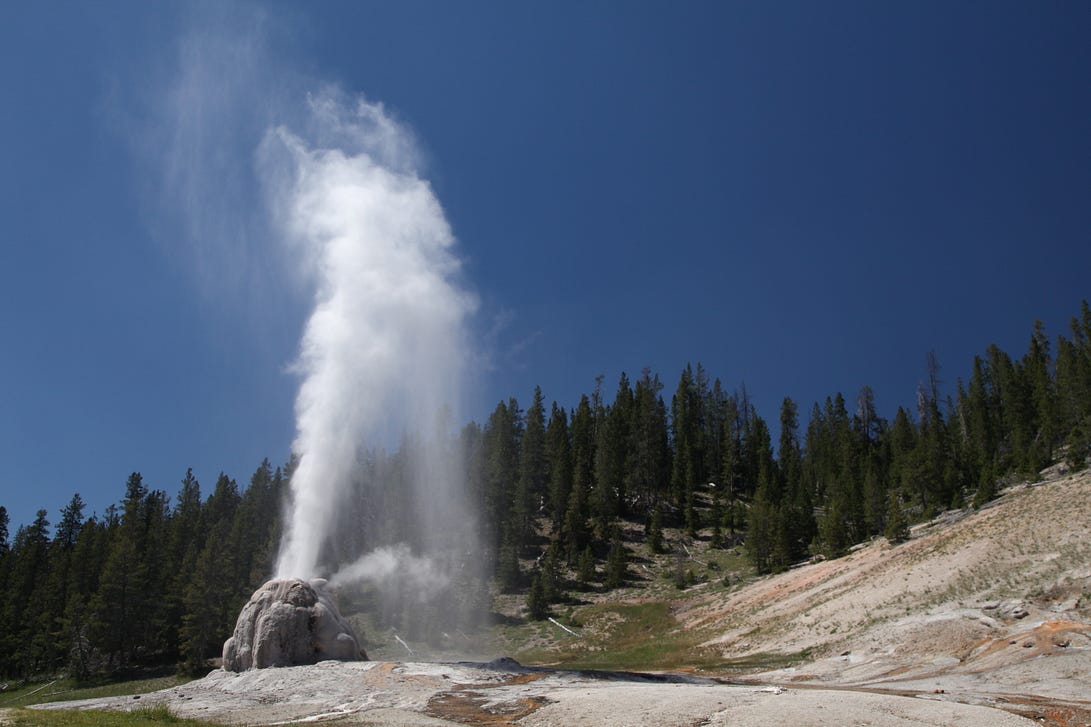
Visiting a geyser is one of the must do activities at Yellowstone. This route takes you on a flat formerly paved service road to Lone Star Geyser. Before your run, get the geyser’s eruption schedule from the Old Faithful Visitor Center and time your run so you arrive for an eruption (a plume of water and steam 45 feet tall). Starting from the Kepler Cascades parking area, follow Lone Star Trail for 2.4 miles over the Firehole River, through the forest and several meadows. Enjoy the show, then turn around and follow the road back to the trailhead. In the summer, this trail can get crowded. Run in the morning or late afternoon to avoid the heat and the crowds.
Canyon Junction Area
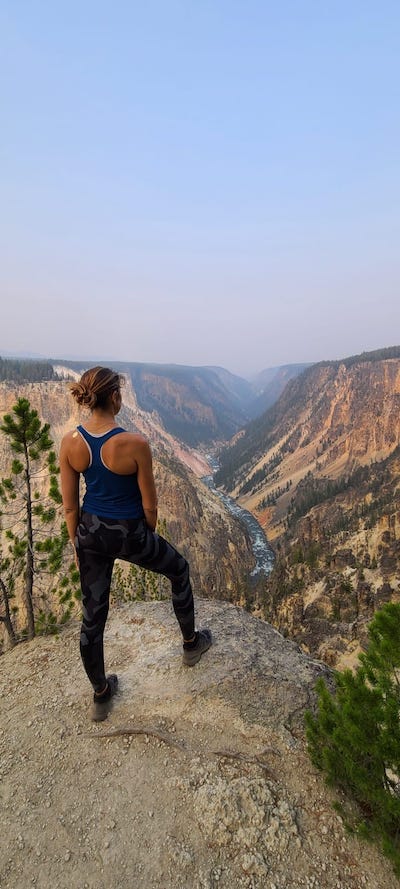
South Rim Trail. 7 miles out and back to Ribbon Lake, 550 foot gain. ROUTE MAP. One of the most scenic and runnable trails in Yellowstone. Partially paved, relatively little traffic. Great canyon views, lakes, thermal features. Start from the trailhead at the end of S. Rim Dr. Run for 1 mile to the Upper Falls View, then head back along the main trail to Ribbon Lake. Mainly an out and back, but a 1 mile diversion to Artists Point is possible. Note: Bring bear spray! Thanks to Aurélie Vilmer for this route!
Sour Creek Trail. 5.1 miles out and back. 400 foot gain. A moderate trail run, not far from canyon village. PRO TIP: Beautiful wildflowers.
Fishing Bridge Area
Storm Point
This exciting loop is full of attractions. Beginning at Storm Point Trail parking area, follow the well maintained dirt path towards Indian Pond. As you approach the pond, keep your eyes peeled for buffalo and waterfowl. If you encounter any buffalo, give them a wide berth. Although peaceful in appearance, they are very dangerous. As you continue on, you will get to Yellowstone Lake and enjoy panoramic views. The path parallels the shore until your reach Storm Point (an area known for it’s yellow-bellied marmots population). At Storm Point, take a moment to enjoy your nearly 360 degree view of Yellowstone Lake along with all the animal activity it attracts. From here, the route continues along the lake shore a short distance before looping back to the right and entering the forest. It eventually breaks out of the forest and rejoins the trail near the trailhead. This route is great for its even elevation and scenic views but can get busy during the day. Time your run for the morning or evening to find seclusion on your run.
Mammoth Hot Springs Area
Bunsen Peak
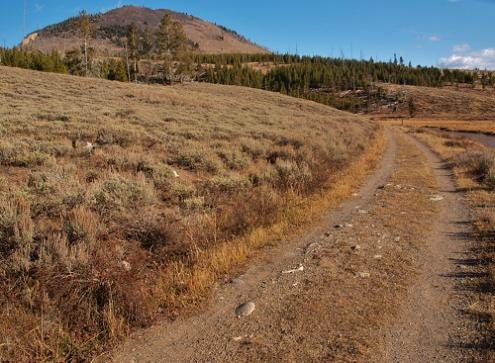
Rescue Creek Trail

Begin at the Rescue Creek Trailhead off of route 89. As you begin your run, cross a large footbridge and up a slight hill to an open expanse with a defined double track. When you need a break, turn around to get views of Electric Peak and Sepulcher Mountain.
About a mile and a half in, the trail enters a notch at the base of Rattlesnake Butte and rises steeply for about 0.3 of a mile and 200 ft. Before this climb is a great place for a 3 mile out-and-back route.
You can also run from the opposite end at the Blacktail Plateau Trailhead. Begin on the Blacktail Deer Creek Trail, then veer left onto the Rescue Creek Trail. Enjoy the scenery as you run through a sagebrush meadow. After about 3 miles you will have reached the highest point on the trail. We recommend turning around here for an enjoyable 6 mile out-and back
Video Highlights: Main Park Road and Geysers (17 min.)

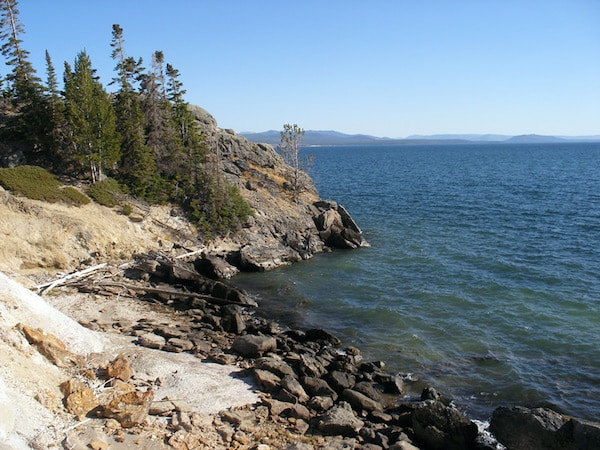
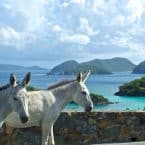

Comment on this Route/Share a Photo!
Share your feedback on this route and see that of other Great Runs users. Click on the image icon to upload a photo. And please let us know if there are notes or changes we should incorporate!